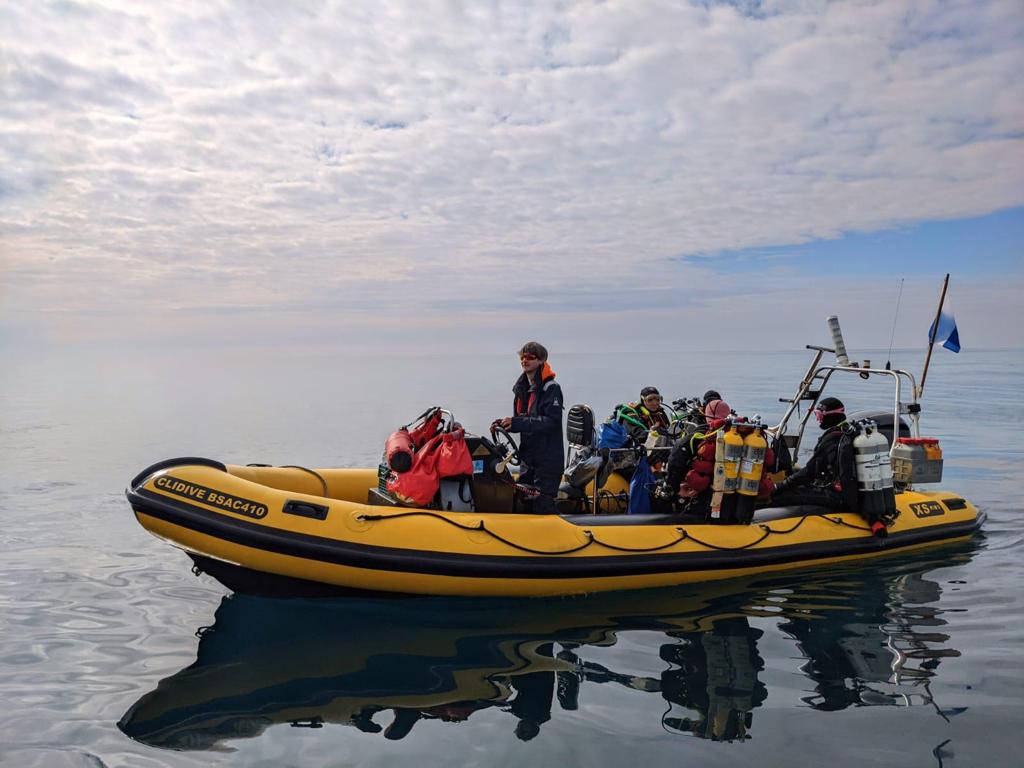by Bosco
On the afternoon of the 29th of May, I joined fifteen other Clidivers (and two dogs) at the Boringdon Arms in Turnchapel for the start of my first Clidive trip and my first dive in UK water. Excited but slightly on edge at the prospect, my concerns were soon assuaged by a very warm and friendly crowd (and perhaps a couple pints of Guinness). That is, until I mentioned I would be diving in a semi-drysuit. “A semi-dry? Are you insane?”
After a restful night at the spartan accommodation of the Mount Batten Centre, we filled our cylinders and loaded them in the boats. This was a double boat trip, and a great opportunity for me to get to know both Blue and Yellow. I had been assigned to Blue, coxed by Mark and Neil, while Ian was commanding yellow.
And so we set off at 10am for the first dive of the day, the Glen Stathallan. This was a fishing trawler sunk in the 70’s to serve as a dive site but was deemed by the Royal Navy to be obstructing the entrance to the port and “dispersed” with explosives. Most of what remains today is a huge boiler, which serves as a perfect hiding spot for conger eels and lobsters. We enjoyed good visibility and very little current, and I had the chance to discover that the semi-dry was keeping me perfectly warm, even in 10 degree water. I had been very surprised at the precision with which Mark and Martin had placed the shot from the boat, till it transpired later that this was far from the case and Niovi and Neil had had to move it!
Yellow meanwhile had gone to the wreck of the James Eagan Layne (or JEL if you’re in the know – I wasn’t). She was an American cargo ship sunk during WWII.
After a quick lunch and an air fill we were back on the boats again, this time for our turn on JEL. By then the current was significantly stronger, and Clarissa and Martin had to abort their dive. We decided to switch sites to the Fort, a 19th century fortress on the Plymouth breakwater, which provides excellent walls. Given we were quite close to two massive Navy frigates, Neil suggested we get permission from Longroom Port Authority, just to make sure. Once they gave the all clear, we were in the water! Although there was a bit of current, Mark, Martin and I enjoyed seeing anemones, worms, spider crabs and all sorts of other wall creatures.
While this was happening, Yellow was on the HMS Elk, originally a trawler but she saw distinguished service during WWI and WWII, until she hit a mine and sank near Plymouth. Nick Barter and Michael had a lovely dive all to themselves, conveniently forgetting to deploy the right signal to the boat to indicate the shot was in position. In any case, all divers were able to enjoy the site except Richard and Errol, who after putting air in the shot went in the wrong direction and never found the ship…
We finished the day with a much-needed warm dinner at Clovelly Bay in Turnchapel, and then off to bed for an early night ahead of ropes off the next morning at 8.30. The first dive of the day was Eddystone Lighthouse, the first ever lighthouse to be built on open sea in… 1699! The current structure is the fourth iteration, the first one having washed away with its inventor inside who was never seen again.
Blue this time counted with Joli as our cox and she expertly led us all the way to the site, which is nearly 15km out at sea. The dive was quite adventurous, with significant surge across the rocks – My Ocean Diver status did not allow Mark and I to seek refuge in the gullies below us, meaning we had to swim a little. This did not prevent us from enjoying the many crabs and lobsters (including blues!) that made their home in the ricks under the lighthouse.
After lunch we headed to Mewstone, an island just of the coast that was once inhabited by a family of smugglers. We had intended to do a drift dive, however the current was not flowing as much as we expected – Perhaps the only dive in the trip where this happened… On this dive, Joli also awarded Niovi the award for the “smallest SMB in the world” – Perhaps we should make it an annual Clidive prize? On the way back Mark and Niovi took the chance to get some boat handling time under Joli’s instructions. Even I got to have a go!
Having recovered our strength with a curry dinner and a bacon butty for breakfast, both boats set off on Monday at 8.15 am for a dive in Hatt Rock. This is a solitary mound peaking at about 25m below low water level, with the rest of the seabed at about 60m, which makes for a very interesting landscape. According to Joli, it used to be very difficult to find this dive site back in the day, and you could head out with no guarantee of ever finding it. Thanks to modern GPS tech, it is now easy enough that it can be planned as part of a normal trip. It was considered possibly the best dive of the trip with no current, great visibility and plenty of fauna to enjoy. Clarissa and I dived the HMS Scylla instead, a frigate decommissioned and sunk in 2004. The weekend ended with a dive on the Tinker Shoal which made for a fun kelp forest to explore.
All in all a fantastic weekend – Special thanks to Mark for planning; Joli, Neil, and Ian for coxing and Nick Silk and Errol who helped load the boats into the trailers from the water.


 We are an LGBTQIA+ friendly club
We are an LGBTQIA+ friendly club